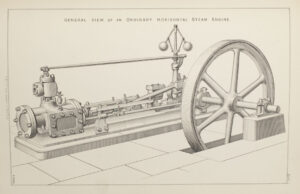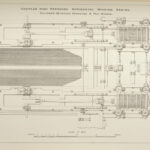The steam engine was the driving technological force of the nineteenth century, and was a crucial component of the Industrial Revolution. MIT owns hundreds of titles on steam engines, of which Rigg’s Practical Treatise is representative. The book is technical, describing in detail the individual components of the steam engine and effectively providing instruction to readers in how to assemble engines of their own.
 Rigg designed and built steam engines himself, and some of his designs are illustrated here. The book also includes 94 plates of technical drawings. In a nod to the steam engine’s surprisingly long history, the upper-left corner of the illustrated title page carries a picture of the aeolipile, or steam ball, a Greek invention from the first century C.E. that is generally considered to be the first steam engine. The Greeks didn’t know what they were onto, though, and treated the device more or less as a toy. Nearly two millenia would pass before a useful steam engine was perfected, ushering in a period of rapid technological progress.
Rigg designed and built steam engines himself, and some of his designs are illustrated here. The book also includes 94 plates of technical drawings. In a nod to the steam engine’s surprisingly long history, the upper-left corner of the illustrated title page carries a picture of the aeolipile, or steam ball, a Greek invention from the first century C.E. that is generally considered to be the first steam engine. The Greeks didn’t know what they were onto, though, and treated the device more or less as a toy. Nearly two millenia would pass before a useful steam engine was perfected, ushering in a period of rapid technological progress.
MIT’s copy bears the autograph of Ch anning Whitaker, a Civil War veteran and member of MIT’s second graduating class in 1869. Whitaker went on to serve as chair of the Department of Mechanical Engineering for 10 years, from 1873-1883. His autograph is dated 1879, so he probably purchased this book while a member of MIT’s faculty.
anning Whitaker, a Civil War veteran and member of MIT’s second graduating class in 1869. Whitaker went on to serve as chair of the Department of Mechanical Engineering for 10 years, from 1873-1883. His autograph is dated 1879, so he probably purchased this book while a member of MIT’s faculty.
 At some point during its history, a small copy of the constitution of the New England Chautauqua Association was slipped between the pages of the volume. Dated 1885, the pamphlet lists Edward Everett Hale as the association’s president. Hale’s statue now occupies a prominent position in the Boston Public Garden. We don’t know whether the pamphlet was added by Whitaker, but it remains with the volume, as we found it.
At some point during its history, a small copy of the constitution of the New England Chautauqua Association was slipped between the pages of the volume. Dated 1885, the pamphlet lists Edward Everett Hale as the association’s president. Hale’s statue now occupies a prominent position in the Boston Public Garden. We don’t know whether the pamphlet was added by Whitaker, but it remains with the volume, as we found it.



